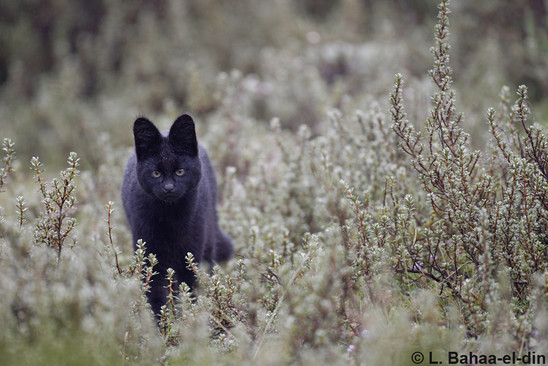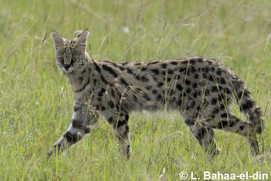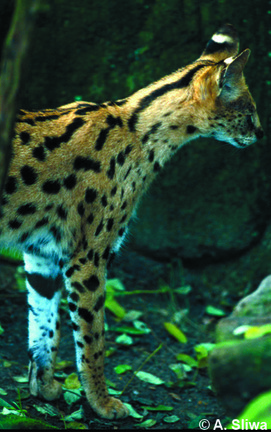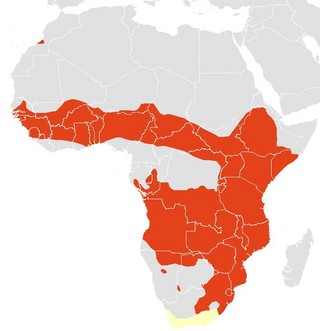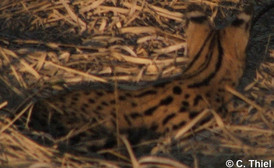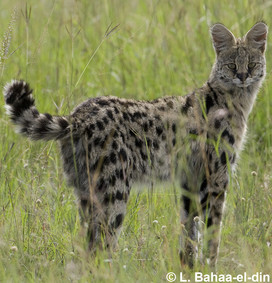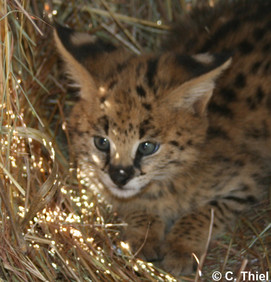Serval
Leptailurus serval
IUCN Red List: Least Concern
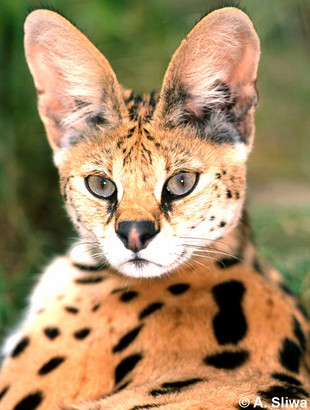
| Weight: | 7-18 kg |
| Body length: | 59-100 cm |
| Tail length: | 20-38 cm |
| Longevity: | up to 22 years |
| Litter size: | 2-4 cubs |

Description
Genetically the serval (Leptailurus serval) is closely related to the African golden cat (Caracal aurata) and the caracal (Caracal caracal). No recent morphological and molecular studies have, however, been conducted. If philogeographical patterns, which are found in lions, cheetahs and savanna ungulates also apply to the serval, then three subspecies can be distinguished:
- Leptailurus serval serval in southern Africa
- Leptailurus serval constantina in West and Central Africa and
- Leptailurus serval lipostictus in East Africa
Further research is needed to clarify the geographical variation in the serval.
The colour of the serval’s coat is pale yellow, yellow-brown or tawny marked with black spots along the sides. These spots vary from freckle-size to large single spots depending on the region. On the neck and shoulders, the spots often merge into stripes. Its underside is whitish-yellowish and unmarked. Black coloured (melanistic) servals are widely recorded mostly in highland areas of eastern Africa, such as in the Aberdare Range (north of Nairobi) or in the Ethiopian highlands. There is also a small spotted coat pattern variation, the so-called servaline morph, which is probably rare. It has so far only been recorded in the Democratic Republic of Congo and in southwestern Uganda. This special coat pattern seems to be associated with dense vegetation and secondary forest.
The serval is well adapted for hunting small prey in long grass with its slim and relatively long legs and its elongated neck. Its hind legs are longer than the front ones. It has long mobile feet and strong curved retractable claws, which are used to capture mice and rats. The head of the serval is small and delicate. Its ears are conspicuously very large, high on the head and close together. They are marked with a distinct white bar on the otherwise black backside. The auditory bullae are correspondingly well-developed, making up about 22% of the skull length. The tail of the serval is relatively short. Their canines are well-developed and they have molars specifically designed to rip rather than chew.
Language/Country | Name |
|---|---|
Algeria (Berber; Kabylia) | ouchiak zilagla; amich boudrar |
Botswana (Ju/hoan Bushman; Setswana) | !'hom!a; tadi |
Ethiopia (Amharic) | aner |
French | serval, chat-tigre, lynx tacheté |
German | Servalkatze |
Guinea-Bissau (Creole) | onca de baga baga |
Malawi (Chichewa) | njuzi |
Namibia(Ju/hoan Bushman) | !'hom!a |
Portuguese | gato serval, gato lagar |
Spanish | serval |
Somalia | muq shabeel, dumad xabashi, shabeel adari, shabeel yer |
South Africa (Afrikaans; Zulu; Xhosa) | tierboskat; ingwenkala; indlozi |
Status and Distribution
The serval is listed as Least Concern in the IUCN red list. It is widely distributed and new records of the species suggest a possible expansion and recolonisation of some areas (e.g. in regions within South Africa, Gabon and Cameroon). Its population trend is assessed as stable across the range. However, the serval seems not to be very abundant anywhere, except for Northern Tanzania where servals are deemed rather common. Servals are considered to be rare in some countries, in Senegal the serval for example could qualify for the category Critically Endangered. The serval is commonly recorded in national parks and reserves but its status outside such protected areas, especially in northern Africa, is not well known. It is assumed that the serval may be quite common in suitable habitat as it is quite adaptable to altered landscape if enough prey and cover is provided. The only population occurring along the Mediterranean coast in Morocco, Algeria and Tunisia (reintroduced) is classified as regionally Critically Endangered. This population is isolated and small, with fewer than 250 mature animals, if it still exists at al
Estimated population densities vary considerably between regions. In the disturbed artificial wetlands in South Africa, density was estimated to be as high as 76 -101 individuals per 100 km², in the Ngorongoro Crater in Tanzania its minimum density was estimated to be 42 individuals per 100 km², on farmland in South Africa, the number was much lower (8 servals per 100 km²) and in Luambe National Park, in Zambia, the density was 10 individuals per 100 km². In Namibia, densities were very low in in Khaudum National Park (1.28 individuals per 100 km²) and Mudumu North Complex (0.63 individuals per 100 km²).
County, region | Individuals per 100 km² |
|---|---|
Botswana | 4.3–9.3 |
Namibia, Khaudum National Park | 1.28 |
Namibia, Mudumu North Complex | 0.63 |
Republic of Congo, Odzala-Kokoua National Park | 7.7–9.8 |
Republic of Congo, Odzala-Kokoua National Park | 10.37–11.81 |
Senegal, Niokolo Koba National Park | 2.51–2.82 |
South Africa, Drakensberg Midlands (farmlands) | 6.5–7.7 |
South Africa, KwaZulu Natal Midlands | 4.3–9.3 |
South Africa, Sadol refinery site in Secunda | 76.20–101.21 |
South Africa, Sadol refinery site in Secunda | 150 |
Tanzania, Ngorongoro Crater | 42 |
Tanzania, Rugha-Rungwa (Miombo woodlands) | 3.11–8.01 |
Tanzania, Rugha-Rungwa (tourist areas) | 2.44–4.49 |
Tanzania, Rugha-Rungwa (wildlife management areas) | 1.34–2.82 |
Zambia, Luambe National Park | 10 |
The serval is can be found in 34 African nations. It inhabits sub-Saharan Africa except for the tropical rainforest and the Sahara Desert. South of the Sahara it is widely distributed and more recently it was again recorded from Gabon, central Namibia, eastern Central African Republic, central South Africa, North West province of South Africa and south western Uganda.
Habitat
The serval inhabits a variety of grassland types such as reed beds, swamps, grass savannahs or marshes, and forests. It prefers rather moist habitats and is often found along rivers or areas with riparian habitat. Due to this association with permanent water sources its distribution is localized over a wide area and within a variety of habitats. The serval does not occur in desert habitats or in the rainforests of Central Africa, but it can penetrate dense forests along waterways and through grassy patches. In northern Africa, the serval is recorded from semi-desert to cork oak forest on the Mediterranean coast. The serval has been recorded up to an elevation of 3,200 m in Ethiopia and up to 3,800 m in Kenya.
The serval seems to be able to adapt to agricultural areas if enough prey, cover and water are available, and is thought to be very tolerant of agricultural development. It may even benefit from forest degradation and transformation into grassland. They have been recorded in high densities on disturbed agricultural lands, which might be a result from the lack of larger carnivores, lack of persecution (poaching, road mortality) and abundance of small prey in these areas. In Gabon, the serval was observed on a logging trail in a rainforest-savannah mosaic habitat.
Ecology and Behaviour
The serval is a solitary and territorial cat species. It is largely crepuscular and nocturnal, resting at midday and occasionally at night. Females, however, have been found to be more diurnal, presumably to avoid predation on their kittens by spotted hyenas. In the heat of the day, the serval often rests in abandoned aardvark burrows or under shady bushes. However, during the wet season the serval hunts as well in the day, and females with kittens increase their diurnal hunting activity. Servals spatially partition habitat to avoid African golden cats and have been found to reduce interspecific competition by specialising on smaller prey species to minimise dietary overlap.
Home ranges of servals are long lasting and may persist for 4 to 9 years. Males have larger home ranges than females. The minimum home range in Ngorongoro (Tanzania) was 11.6 km² for one adult male and 9.5 km² for one adult female over four years. In the Drakensberg Midlands, home ranges varied from 38-46 km² and 6-7 km² for males and females respectively. The home ranges of males seem to overlap with those of females whereas the female home ranges show minimal overlap. In South African ranch land, the home ranges reached 16-20 km2 for two adult females and 31.5 km² for one male. In South African areas with high serval densities, home range between 1-2 km². Males scent mark more often than females. Aggressive behaviour between servals is unusual and rare.
The serval locates prey in tall grass or reeds primarily by hearing. Its large ears and excellent hearing sense help the serval to localise its prey and make it a very efficient hunter of small mammals and birds. It makes a characteristic high leap as it pounces on a prey animal, striking it on impact to prevent escape in thick vegetation. A single pounce may span 1- 4 meters and may be over a meter high. Adult animals will jump up to 3 m high from standstill. Another type of leap is vertical: birds and insects are seized from the air by "clapping" the front paws together or striking with a downward blow. This characteristic hunting technique enables the serval to catch some species that would otherwise not be available. The serval also digs out prey from holes and crevices. Hunting success in Ngorongoro averaged 50% with no significant difference between day and moonlit night. When taking only rodents into account, hunting success can even reach 81%. When the serval does not catch its prey in the first attempt, it repeatedly jumps up and down on the spot. In this way, should a bird take off, the serval is quick to catch it with its front paws.
The reproductive season is not seasonal but birth peaks appear to be correlated with wet seasons when prey densities are at their highest due to new vegetative growth. The estrus lasts for 4 days and the gestation period for 65-75 days. Sexual maturity is reached with 18-24 months. The serval’s litter size often varies between 1-5 kittens. Young are weaned around 3-4 months and independent at 6-8 months old. Nevertheless, newly independent juveniles, tolerated by their mothers, may circulate within their natal range for periods up to and over a year.
In contrast to many other cat species, the serval seems to adjust quite well to agriculture and livestock farming, but does reduce its diurnal behaviour in intensively farmed areas.
Prey
The serval’s main prey species are small mammals, especially rodents, with preferences for vlei (swamp) rats and Nile rats. If no rats are available, smaller mice with an average eight of around 70 g are preferred. Rodents make up 80-90% of the serval’s diet. The serval takes also hares, birds such as queleas, waxbills or weavers, reptiles such as lizards and snakes, frogs, fishes and insects, but more when rodents are not abundant. The serval generally does not take larger prey and were only rarely observed to kill duikers and fawns of smaller antelope species. Independent sub-adult servals tend to take more small prey than adults. Servals rarely prey on livestock but occasionally kill poultry or take young sheep or goats. In Botswana, servals have also been found to predate on aquatic vertebrates (Nile crocodile and fish).
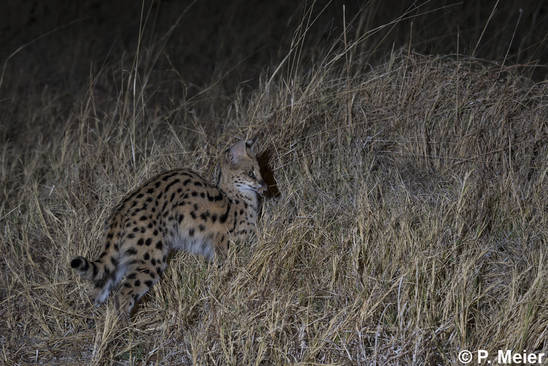
Main Threats
The main threat to the serval is the loss and degradation of wetland habitat mostly caused by increasing urbanization and land use changes. Such wetlands show high rodent densities compared with other environments and are the core areas of serval home ranges. The degradation of grassland habitat through burning and over-grazing by livestock leads to a reduced abundance of small mammals and therefore negatively affects the serval. Additionally, the expanding road network poses a significant threat to serval survival. On a road in South African wetlands, 5 serval carcasses were recorded per 100 km per year.
Even though international legal trade is declining, some trade in serval skins is still reported from many countries. In Senegal, Gambia and Benin, for example, skins are traded in large quantities. Serval furs are often marked as “cheetah” or “leopard” fur. Also in Morocco, trade with serval fur still occurs. These furs could come from another country or indicate the ongoing presence of servals in this country. In West Africa, serval furs are mainly used for ceremonial or medicinal purposes. Economically, the furs are of high value and they are mostly sold on local markets. The extent of the trade in serval skins is not known. It seems that it is mainly domestic and tourist oriented. Frequently, the serval is also killed through indiscriminate predator control methods and it is hunted for sport. The serval climbs on trees when chased by hounds, making it an easier target. Its localized distribution around water sources may also increase its vulnerability to hunting pressures. Young servals but also adult ones can be killed by leopards, hyaenas and lions (Panthera leo).
In rural areas throughout Africa, the serval is persecuted as retaliation for poultry predation. It rarely preys upon livestock, but in South Africa it is hunted for this reason. Serval presence, however, could even be considered beneficial to farmers since it preys upon rodents. A single serval can eat up to 4,000 rodents per year. The serval is perceived as a problem for chickens in some areas such as the Chebera-Churchura National Park in Ethiopia.
Conservation Effort and Protection Status
The serval is protected under Appendix II of CITES. It is however not protected across most of its range. Hunting is prohibited in Algeria, Botswana, Congo, Democratic Republic of the Congo, Kenya, Liberia, Morocco, Mozambique, Nigeria, Rwanda, Tunisia and South Africa (Cape Province only). Hunting is regulated in Angola, Burkina Faso, Central African Republic, Ghana, Malawi, Senegal, Sierra Leone, Somalia, Tanzania, Togo, Zaire and Zambia. It is not legally protected in Benin, Cameroon, Ethiopia, Gabon, Gambia, Guinea Bissau, Ivory Coast, Lesotho, Malawi, Mauritania, Morocco, Namibia, Niger, South Africa, Sudan, Swaziland, Tunisia, Uganda and Zimbabwe. No information is available in Burundi, Chad, Djibouti and Guinea. There are no specific serval conservation networks, conservation plans or conservation projects across its range.
One key aspect of serval status is the conservation of its habitat, especially of wetlands. More surveys and monitoring are needed to get more information about the serval’s conservation status and to have a better idea of the impact of hunting activities as well as habitat destruction on its status and distribution.
